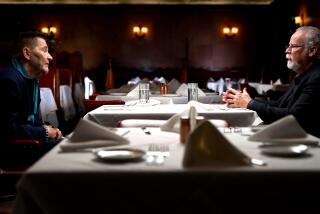1994: A PORTFOLIO : A Case Full of Indelible Images
- Share via
Haunting images of the O.J. Simpson saga linger on, overshadowing the millions of words written about the case.
The words are important. Words and evidence will determine Simpson’s fate. Testimony will tell us much about the efficiency and fairness of the criminal justice system. Important legal precedents may emerge from the courtroom conflict.
But it’s the images, the pictures of the celebrity defendant and others, that have made the trial such a compelling event.
The high point was Simpson’s televised freeway trek, four days after the discovery of the savagely stabbed bodies of his former wife Nicole Brown Simpson and her friend Ronald Lyle Goldman. Remember the Bronco being followed by a squadron of police cars while people gawked and cheered from overpasses? This occurrence was so out of the ordinary that it preempted network television and held millions captive to their TV sets through that early Friday evening of June 17.
Even before this unimaginable journey, though, the pictures--televised and in the newspapers--were uniquely gripping.
There was, for example, the driver’s license mug shot of Nicole Simpson published just after the murders, her Southern California good looks captured through the lens of a Department of Motor Vehicles camera. Goldman, in a family photo, is young and serious in coat, dress shirt and tie. Simpson, the famous and beloved football hero, is photographed through the window of his attorney’s car. He appears stricken, his left hand raised as if he was trying to shield his face from the cameras or is about to massage away a headache. In another picture, a tieless Simpson looks downward and his attorney, Robert L. Shapiro, puts his right hand on Simpson’s shoulder to comfort him.
All this was played out against a backdrop that seemed pure L.A.--freeways snaking through flatlands; the familiar Parker Center police headquarters; the boxlike Criminal Courts Building; the jail and, of course, Brentwood, the foothill home of the affluent and those struggling to catch up with them.
So dazzling are the pictures that they have blinded people to the substance of a case that is much more important than its tabloid image. Significant legal issues have already been raised, and we’ll be hearing a lot more about them in the months ahead.
The jury selection process, for example, spotlighted a long-ignored component of the criminal justice system, the jurors. With their deliberations under sharp worldwide scrutiny, the Simpson jurors will be put to the test.
The competence of the Los Angeles Police Department and the coroner’s office will be on trial. Defense attorneys and their experts will subject every move, every minute of their investigations to intense scrutiny.
At the heart of the detective work will be a sophisticated and complicated crime-fighting technique, the matching of DNA, a substance found in cells. The prosecution will try to prove that DNA in blood and hair found at the Simpson mansion and at his former wife’s condominium match the former football player’s DNA. California appellate courts have split on the admissibility and reliability of DNA matching in criminal cases and this case will be important in determining the future use of such evidence.
The televised trial will provide the public with a long seminar on criminal law. When it comes to government, we fasten our attention on presidents, goto do with shaping our communities as the other branches of government. With big and talented prosecution and defense teams battling every step of the way, the public will get an education about the criminal justice system.
People will learn about the media, too. The Simpson case has provoked unprecedented debate over the media’s role in criminal trials. It will continue through the trial, giving the public insight into a powerful institution and its value to society.
As noteworthy as all this is, however, we’ll continue to be drawn to the images, the pictures of the accused, the survivors, the lawyers, the judge and the many supporting players. They will be with us on television, in the newspapers and magazines and in the supermarket tabloids. These pictures, more than words, convey the tragedy and horror of the story.
More to Read
Sign up for Essential California
The most important California stories and recommendations in your inbox every morning.
You may occasionally receive promotional content from the Los Angeles Times.













